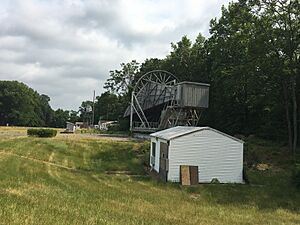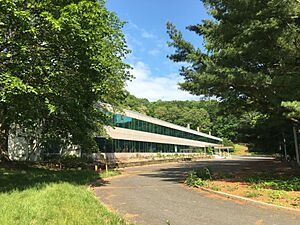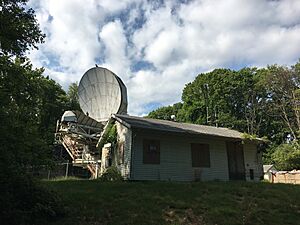Crawford Hill facts for kids
Crawford Hill is a well-known hill in Holmdel Township, New Jersey, United States. It is the highest point in Monmouth County. It is also the highest spot on New Jersey's coastal plain, reaching 391 feet (119 m) above sea level. Crawford Hill is most famous for being the home of a Bell Telephone Laboratories research center. This center was an extra part of the main Bell Labs Holmdel Complex, which was about three miles away. The 43-acre (17 ha) property includes a main research building and other scientific tools, like the historic Holmdel Horn Antenna.
About the Hill
Crawford Hill is part of a landform called the Navesink Highlands. This area has rolling hills that get higher as you move away from the coast. Long ago, it was a wooded area that looked over the first farms in the region. The hill is named after the Crawford family, who were important in Holmdel. Its height was first measured around 1888.
Around 1900, part of Crawford Hill was leveled. This made it easier for the Holmdel and Keyport Turnpike to pass through. In the 1920s, driving over the hill was a popular activity for new car owners. By the 1930s, the hill had several roads and working gravel pits. These pits were part of WPA projects, which created jobs.
Crawford Hill overlooks the Garden State Parkway. On the other side of that road is Telegraph Hill. If there were no trees blocking the view, you could see Lower New York Bay and even parts of the New York skyline.
In the 1940s and 1950s, amateur radio groups used the hill. They set up field stations to contact other radio enthusiasts. The Jersey Shore Amateur Radio Association won contests in 1946 and 1958 from this spot. Crawford Hill has also been a good place to find fossils.
Bell Labs on Crawford Hill
Bell Telephone Laboratories first bought land in Holmdel Township in 1929. Early work on radio astronomy happened nearby in the 1930s. This included research by Karl Jansky. Many other important communication discoveries also took place at the main Bell Labs site.
By 1950, Bell Labs was using Crawford Hill for experiments with microwave transmission. An early antenna there received signals from a tower 22 miles away in Murray Hill, New Jersey.
In 1955, a large 60-foot dish antenna was built on Crawford Hill. It was called "The Big Dish." This antenna was used for sending and receiving very high frequency telephone and television signals. It also explored how signals could travel over the horizon. Important scientists like Arthur B. Crawford, John C. Schelleng, and Harald T. Friis led this project. The 60-foot antenna was so big that drivers on the Garden State Parkway could easily see it.
In 1959, construction began on the Holmdel Horn Antenna. This antenna was designed to receive radio signals bounced off a satellite. A transmitter in Goldstone, California, would send the signals. Meanwhile, "The Big Dish" would send signals in the other direction. This project was called Project Echo. In 1960, it successfully completed the first passive communications satellite experiment. The first message sent this way was a recorded greeting from President Dwight D. Eisenhower. Also in 1960, the 60-foot antenna at Crawford Hill was used to bounce a radio signal off the Moon. This signal was then received in Goldstone.
In 1962, a smaller two-story building was built on Crawford Hill. It housed about 140 researchers working on Project Echo. They also worked on waveguides, masers, microwave radio, antennas, and satellite communications.
After Project Echo finished, two Bell Labs scientists, Arno Penzias and Robert Wilson, used the Holmdel Horn Antenna. Starting in 1964, they were trying to measure radio signals. They kept detecting a strange, steady noise. They realized this noise was actually cosmic microwave background radiation. This discovery strongly supported the Big Bang theory. Penzias and Wilson won the 1978 Nobel Prize in Physics for their work. The Holmdel Horn Antenna was recognized as a National Historic Landmark in 1988.
Later, the laboratory researched wireless and fiber-optic communication. Award-winning Bell Labs researchers like Herwig Kogelnik and Gerard Foschini worked at Crawford Hill. Herwig Kogelnik won important awards for his work on fiber optic technology. Gerard J. Foschini received an award for his inventions related to communication systems with multiple antennas.
Over time, ownership of the Bell Labs annex changed. It went from AT&T Corporation to Lucent, then to Alcatel-Lucent, and finally to Nokia. The main Bell Labs Holmdel Complex closed in 2007, but the annex at Crawford Hill stayed open for a while. In October 2019, the annex property was put up for sale.
In January 2021, Nokia sold the main research building and the rest of the 43 acres (17 ha) property. It was sold for about $3.6 million to a private buyer. The remaining 66 Bell Labs researchers moved to the Murray Hill campus. This sale ended Bell Labs' six-decade presence in Monmouth County.
Future of the Site
After the sale, the main building and other structures at the annex started to look run down. The sale also raised concerns about the future of the Crawford Hill site and the Holmdel Horn Antenna. People worried that developers might build new projects there. The buyer of the land did propose building a senior housing center.
The Holmdel Planning Board decided to study the issue in 2023. Neighbors, groups that wanted to protect the site, and astronomy fans all opposed the development plan. They collected about 8,000 signatures on a petition from people around the world. Holmdel officials even thought about using eminent domain to buy the land.
However, in October 2023, a deal was made between the township and the developer. The Holmdel Township Committee agreed to pay $5.5 million for 35 acres (14 ha) of the land. This included the area where the antenna sits. In January 2024, the purchase of these 35 acres was completed. The plan is to name it the Dr. Robert Wilson Park. The exact form of the park is still being decided. The two-story main building remained with the developer. There are ideas to develop it like the Bell Works complex at the former Bell Labs Holmdel site. Dr. Wilson, who lived nearby and still had keys to the antenna, approved of this agreement.
Images for kids







